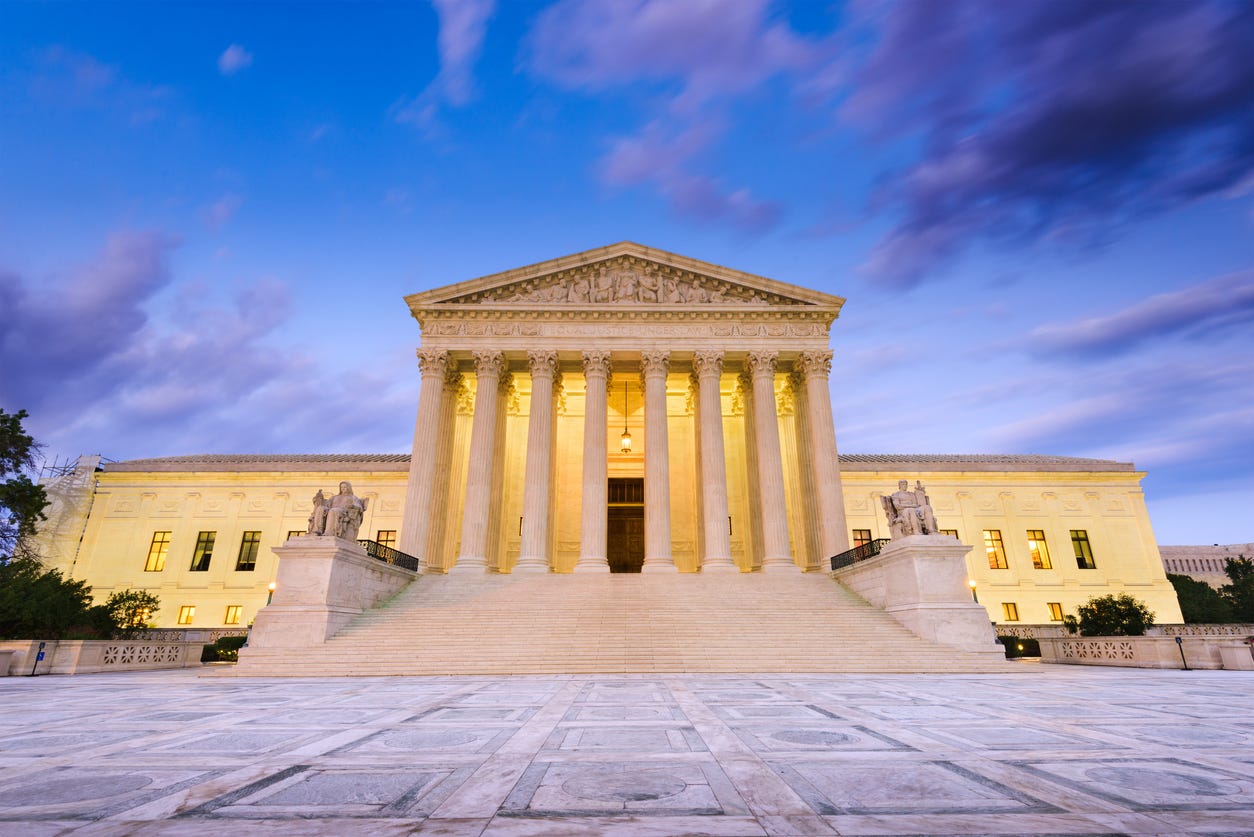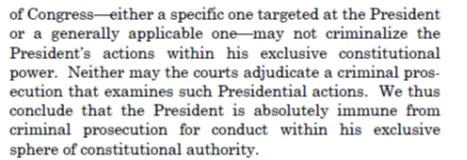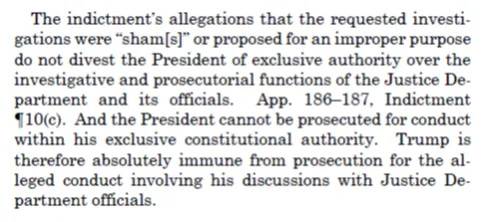*I am trying something new this week by putting the written article and the corresponding podcast episode together in the same post. Please feel free to comment and let me know your thoughts about combining the two formats.
The Article. As my readers undoubtedly know, the much awaited decision from the United States Supreme Court in Trump v. United States was handed down last week. The High Court found the United States Constitution recognizes Presidential Immunity for a President’s official acts. Yet, there is much more to the SCOTUS decision than that. Today, we will take a closer look at the decision.
The case before the Supreme Court arose out of the Special Counsel’s DC Indictment of President Trump in Federal Court. If you need to refresh your memory about the nature of this utterly bogus political farce of an Indictment, I previously wrote about it at length in my Substack article The Bogus DC J6 Trump Indictment. Take a look at that if you need to refresh your memory.
I previously issued my predictions about how I expected SCOTUS to rule on the case. My thoughts on the matter were informed by some other legal analysts, chief among them William Shipley, a former federal prosecutor and, currently, a defense attorney handling dozens of J6 cases. He has a Substack called Shipwreckedcrew's Port-of-Call, be sure to check it out. My predictions, as informed by Shipley and others, proved to be correct.
The Holding
SCOTUS essentially recognized two forms of Presidential Immunity: (1) absolute immunity for actions within the President’s “conclusive and preclusive” constitutional authority and (2) presumptive immunity for all of a President’s official acts. The Court recognized no immunity for unofficial acts.
The Court went on to provide some illustrations of official acts outlined in the Indictment implicating the immunity and provided guidance on how lower courts are to decide what acts are “official,” and what acts are not “official,” and what is to be done with evidence pertaining to “official” acts.
Absolute Immunity
The opinion highlights the powers granted to the President by Article II of the Constitution, including the pardon power, commanding the Armed Forces, appointing public ministers and Supreme Court Justices, among others. The Court further noted the Constitution grants the President complete, unfettered power to remove the federal officers he appointed. When exercising these powers, Congress “cannot act on and courts cannot examine” the President’s actions and the President enjoys absolute immunity from prosecution. The Court held:
Presumptive Immunity
For official acts of the President not falling within his “conclusive and preclusive” constitutional authority the Court recognized, “presumptive immunity,” at a minimum. The Court stated this presumptive immunity as follows:
Importantly, the Court further stated it was not yet deciding “at this stage of the proceedings” whether this immunity is “absolute.” Basically, SCOTUS requires a record to be developed in the trial court about the “official” and “unofficial” acts and reserves the right to find this form of immunity for “outer perimeter official acts” is also absolute. So, the jury remains out, so to speak, on that question. Presumably, if the lower courts and the Biden Regime prove themselves unable to handle these matters properly, the Court could also recognize “absolute immunity” for the remainder of a President’s official acts.
How to tell what are “official” and “unofficial” acts
The opinion provides extensive guidance on how the lower courts should differentiate between “official” and “unofficial” acts. The analysis begins by “assessing the President’s authority” for taking a particular action, i.e., statutory, constitutional or custom. The Court specifically notes the difficulty determining what are official acts and what are not and held, because of that difficulty, “. . . the immunity we have recognized extends to the ‘outer perimeter’ of the President’s official responsibilities, covering actions so long as they are “not manifestly or palpably beyond (his) authority.’”
Inquiring into “motives” prohibited
In a clear jab at the hyper-politicized DC District Court and DC Circuit Court of Appeals the Supreme Court prohibited courts from inquiring “into the President’s motives,” when “dividing official and unofficial conduct.” An inquiry into the President’s motives would “. . . risk exposing even the most obvious instances of official conduct to judicial examination on the mere allegation of improper purpose . . ..” So, SCOTUS prohibited it. That slammed the door shut on more shenanigans from the Special Counsel and the District Judge in DC. They do not get the opportunity to delve into or question the President’s motives when evaluating official vs. unofficial conduct.
Alleged violation of law does not render an act unofficial
In another not-so-subtle jab at the lower courts, SCOTUS further instructed courts may not “deem an action unofficial merely because it allegedly violates a generally applicable law.” Otherwise, Presidents would be subject to trial on “every allegation that an action was unlawful,” thereby gutting the immunity. Once again, this closes the door on what would have otherwise been abuse by the Special Counsel and his “rubber stamp” trial judge in DC.
The Court then turned to the Indictment itself
SCOTUS then reviewed the conduct alleged in the Indictment. The High Court noted the Indictment “broadly alleges that Trump and his co-conspirators” sought to overturn the 2020 election results, that they allegedly conspired to “obstruct the January 6 congressional proceeding at which electoral votes are counted and certified” and that to do so Trump and company “allegedly attempted to leverage the Justice Department’s power” to try to convince “certain States” to reject the certified electors with slates of alternate electors. The Court further noted the Indictment includes claims about Trump’s communications with Justice Department appointees and threats to fire or replace certain appointees who would not follow his instructions to investigate what Trump claimed was voting fraud.
SCOTUS found the allegations regarding the Justice Department implicate President Trump’s “conclusive and preclusive” constitutional authority and stated:
The Supreme Court just killed that part of the J6 Indictment. Go back and read the Indictment. The allegations about President Trump’s interactions with the Justice Department, his Cabinet, other appointed Federal officers and White House attorneys permeate the document. All of those allegations are done.
Next, the High Court turned to the interaction between President Trump and Vice President Pence. The Indictment, as the Court noted, alleges Trump and his co-conspirators “attempted to enlist the Vice President to use his ceremonial role at the January 6 certification proceeding to fraudulently alter the election results.” The Court noted the role of the Vice President in our constitutional scheme and the fact the President and Vice President are closely aligned, work together and that the VP performs important functions “at the will and as the representative of the President.”
The Court observed “Whenever the President and Vice President discuss their official responsibilities, they engage in official conduct,” and the Indictment’s allegations that Trump “attempted to pressure the Vice President” to do as Trump requested at the certification proceeding constituted “official conduct, and Trump is at least presumptively immune from prosecution for such conduct.” The Court put the burden of proof on the Government to rebut the presumptive immunity and remanded the case to the District Court to determine if the Government is able to overcome the presumption of immunity.
The Court then described the remainder of the Indictment as covering “. . . a broad range of conduct,” including interactions with persons outside of the Executive Branch, with state officials, private parties and the general public.” The Court noted the vast disagreement among the Trump and Government camps over whether or not these communications or actions are “official” or “unofficial” conduct. The Court remanded the case to the District Court to determine if the conduct alleged is official or unofficial.
Finally, the Court turned to the Indictment’s allegations about President Trump’s conduct on January 6, 2021. The Court generally described the Indictment’s allegations and stated, “The alleged conduct consists largely of Trump’s communications in the form of Tweets and a public address.” (The Court further noted the Indictment includes “only select Tweets and brief snippets of the speech Trump delivered on the morning of January 6 omitting its full text or context.”) The Court noted the President possesses “extraordinary power to speak to his fellow citizens and on their behalf” and went over a host of reasons why public speech by the President may be official conduct. Again, the Court remanded the case to the District Court for the record to be developed with the full context of communications to determine what is official and what is not.
What happens to the official conduct?
The Supreme Court identified some conduct alleged in the Indictment to be “official” conduct (Trump conferring with his DOJ and officials and Trump and Vice President Pence’s communications). The High Court then tasked the District Court to divide the remainder of the conduct alleged in the Indictment between official and non-official conduct.
What happens to the “official” conduct? Simple, the Supreme Court held the official conduct is expunged or excluded from the Indictment with the lower court to “ensure that sufficient allegations support the indictment’s charges without such conduct.” SCOTUS ruled the evidence of official conduct may not be presented to, argued before or in any way presented to a jury, otherwise the “intended effect” of the immunity would potentially be defeated by a clever prosecutor or an unsympathetic jury. The official conduct cannot be used to support the Indictment in any way.
What happens now?
The case is remanded or, sent back, to the District Court for it to (1) excise from the Indictment the conduct the Supreme Court expressly recognized in the opinion as “official conduct” and (2) conduct additional hearings to determine what other conduct alleged in the Indictment is “official conduct” and “unofficial conduct,” and exclude the official conduct from the Indictment, then (3) determine if the remaining allegations of the Indictment, after the official conduct is removed, are sufficient to support the Indictment’s charges.
The District Court’s decision on these questions will be immediately appealable to the DC Circuit with, thereafter, potential additional review by the Supreme Court.
The End Result
The purpose behind the Indictment, in my opinion, was to railroad Trump to trial before an unfavorable judge, with the most anti-Trump jury pool in the Country, to get a conviction before the 2024 election to derail Trump’s candidacy. The Supreme Court’s decision kills the original intended purpose of the Trump v. United States Indictment in DC. Whether the case will even be able to move forward at all remains to be seen, but no matter what happens, the case will not go to trial before the November 2024 election.
Keep in mind, two of the Indictment’s four charges against President Trump were for allegedly attempting to “obstruct an official proceeding” under 18 U.S.C. §1512(c)(2). The Supreme Court decided another case on June 28, 2024, rendering the use of this statute much more difficult. See Fischer v. United States. I plan to write about that case separately, but suffice it to say for now that these two charges are probably not going anywhere against Trump (at least without a new or “superseding” indictment).
The DC Indictment of President Trump is on life support. It may not survive at all. It certainly will not get to trial before the Presidential Election in November. To the extent the Democrats, the Biden Regime and Never Trumpers hoped this illegitimate, garbage Indictment would derail Trump’s candidacy it is dead altogether. In short, the Biden Regime’s effort to railroad Trump to prison was dealt a massive blow.
In a future article, I will outline the potential effect of the Trump v. United States decision on the New York Alvin Bragg case against Trump, the Georgia RICO case against Trump and the Florida documents case in federal court. As mentioned above, I will highlight the effect of the Supreme Court’s decision in Fischer v. United States in a future article. Finally, I hope to write yet another article about the hysterical dissent in the Trump Presidential Immunity case.
For now, I hope my readers have a better understanding of what the Supreme Court actually did in the Trump v. United States decision.
(Don’t forget my new book, Fake News Exposed: 25 of the Worst Media Lies about Conservatives, Guns, COVID and Everything Else. To book download a free copy, just visit my website DanielRStreet.com. You may pick up a copy of one of my other books at Amazon.)















Share this post